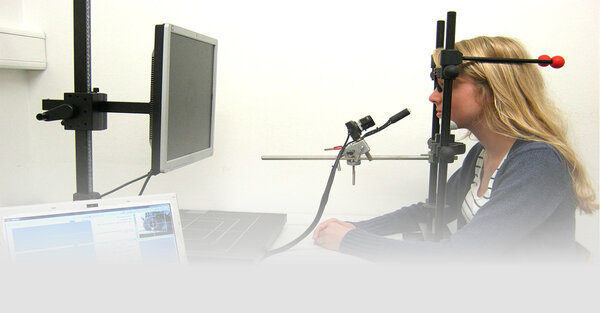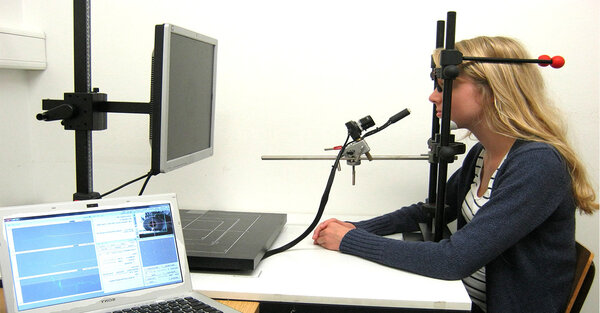

Playing video-games is a widely distributed leisure activity in our society. In order to estimate the consequences of video-game play, we study the details of eye movements and pupil light responses as well as perceptual performance affected by shifts of attention. Our results clearly show that video-game players (VGPs) have shorter saccadic reaction times in general compared to non-players (NVGPs). In addition, VGPs seem to have a more efficient control of attention. The precision of gaze movements is not different between VGPs and NVGPs. Therefore, we are able to rule out the explanation that VGPs show shorter latencies because of reduced precision of their gaze movements.
Another peculiarity of our society is the demographic changes. The amount of older individuals is increasing substantially. Therefore, the issue of healthy aging becomes more important. We decided to examine the effects of aging with respect of two types of goal-directed eye movements: saccades and smooth pursuit eye movements.
Effects of video-game play
More than 46% of the 12 to 19 year old Germans consume video-games every day. Despite this wide distribution, the consequences of video-game play are heavily and controversially discussed. We decided to examine the consequences of video-game play by means of multiple studies of eye movement paradigms as well as perceptual tasks.
Please do not look at the target!
We asked our subjects to perform a very simple eye movement task. They were instructed to generate an eye movement response opposite to the presentation of a visual target. If the target was presented on the left hand side, they should move their eyes to the right. These eye movements are called anti-saccades. However, in some trials, the subjects were not able to suppress the visual-grasp reflex to look at the target. These directional errors are quite similar to eye movements directed voluntarily towards the target (pro-saccades). The directional errors are generated by the superior colliculus in the midbrain. The cognitively driven anti-saccades result from neuronal activity of the frontal cortex, i.e. the frontal eye field (FEF). The frequency of directional errors can be used as error rate. The error rate gives a measure of the executive control function of the frontal lobe.
Our sample consists in the gaze movements of 55 subjects aged 15 to 31 years. Subjects were classified as VGPs (35) or NVGPs (20), respectively, based on the amount of their daily video-game play. VGPs played at least one hour per day.
First, we analyzed saccadic reaction times (SRT) of our subjects. In general, directional errors had approximately 100 ms shorter SRTs as anti-saccades. The saccadic latencies of VGPs were significantly shorter than latencies of NVGPs. In addition, saccadic peak velocity of directional errors was significantly higher compared to the peak velocity of anti-saccades. Finally, peak velocity of both types of saccades was higher in VGPs compared to NVGPs.
The shorter saccadic reaction times do not result from an increased error rate in VGPs. We did not find different error rates for VGPs and NVGPs. Therefore, we conclude that the executive control function of the frontal lobe is not affected by the daily consumption of video-games.
Speed of attention shifts?
(Thesis of Helene Wiesmann)
We hypothesized that shorter saccadic reaction times may be caused by faster information processing in VGPs. To test this hypothesis, we performed a perception study. We asked our subject to report the property of a visual target. The subjects were informed about the location of the target by a visual cue. The cue onset asynchrony was varied between 0 and 600 ms. Our sample consisted in 63 VGPs and 53 NVGPs.
VGPs showed a clear advantage in perception expressed as the amount of correct responses. However, our results do not reveal any differences in the temporal pattern of attention shift of VGPs and NVGPs.
Countermanding tasks
(Thesis of Carolin Töpfer and Verena Lohmüller)
In certain conditions, it might be beneficial to suppress an already intended action. In a first study, we asked our 80 subjects to press as fast as possible a key when a green rectangle appeared. As expected, VGPs showed shorted reactions times as NVGPs. Secondly, we changed the paradigm to a Go/No-Go task. In 50% of the trials, the green rectangle changed its color to red indicating to suppress the key press. We used stimulus onset asynchrony (SOA) from 16 to 320 ms. The latency of the Go trials was clearly increased compared to the first experiment. We calculated the stop signal reaction time (SSRT) from the amount of correct responses in the No-Go trials. SSRT gives the minimal SOA for successful suppression of the key press. Across all subjects, we found a mean SSRT of 250 ms. There was no significant difference between the SSRT of VGPs and NVGPs, respectively.
In a second study, we analyzed the suppression of already intended eye movements. Compared to the key press study, the SSRTs in the saccade task were approximately 100 ms shorter. We did not find any significant differences between VGPs and NVGPs either.
Publications
Oculomotor Laboratory's complete list of publications
Selected Publications
Mack DJ, Ilg UJ.; The effects of video game play on the characteristics of saccadic eye movements. Vision Research. 2014; 102: 26-32
Ilg UJ. The role of areas MT and MST in coding of visual motion underlying the execution of smooth pursuit. Vision Research 2008;48:2062-2069
Ilg UJ, Schumann S. Primate area MST-l is involved in the generation of goal-directed eye and hand movements. Journal of Neurophysiology 2007;97:761-771
Ilg UJ, Churan J. Motion perception without explicit activity in areas MT and MST. J Neurophysiol 2004;92:1512-1523
Ilg UJ, Schumann S, Thier P. Posterior parietal cortex neurons encode target motion in world-centered coordinates. Neuron 2004;43:145-151
Completed Dissertations
David Mack (2015)
Consequences of Video Games on Oculomotor Behavior and Attention and Additional Implications for Healthy Aging
Prof. Dr. U. Ilg
Ulrich Biber (2011)
Visuelle Illusionen oder die Illusion des Sehens: Einflüsse von Augenbewegungen auf die visuelle Wahrnehmung
Prof. Dr. U. Ilg
Ines Trigo-Damas (2010)
Speed illusions of human subjects and rhesus monkeys
Prof. Dr. U. Ilg
Stefan Schumann (2004)
Fakultät für Angewandte Wissenschaften, Universität Freiburg
Blickfolgeaktivität in Area MST von wachen Affen
Prof. Dr. U. Ilg
Jan Churan (2003)
Philosophische Fakultät, Universität Köln
Verarbeitung von Bewegungsreizen im Parietalkortex von Makaken
Prof. Dr. U. Ilg
Completed Master, Diploma and degree theses
Tatjana Alf (2020)
Lassen sich antizipatorische Augenfolgebewegungen durch Videospiele verändern?
Prof. Dr. U. Ilg
Berit Böhling (2020)
Consequences of Video Games on Saccadic Reaction Times and the Occurence of Express Sakkades
Prof. Dr. U. Ilg
Laura Pelzer (2019)
Augenbewegungslatenzen bei Patienten mit zervikaler Dystonie
Prof. Dr. U. Ilg
Joana Stäb (2018)
Korrelation zwischen Videospielen und einfachen mathematischen Fähigkeiten
Prof. Dr. U. Ilg
Franziska Uhl (2018)
Vergleich von Richtungsfehler, Pro- und Anti-Sakkaden als Reaktion auf isoluminante Reize unterschiedlicher Wellenlänge
Prof. Dr. U. Ilg
Petra Segsa (2017)
Der visuelle Zahlensinn - Eine Untersuchung von Adaptionsphänomenen beim Vergleich von Punktmengen und Zahlensymbolen
Prof. Dr. U. Ilg
Finn Klingler (2017)
Antizipatorische Augenbewegungen: Untersuchung des Einflusses von Videospielen
Prof. Dr. U. Ilg (Biologie 2017)
Anna-Lena Kämpf
(2017)
Flash-lag Effekt bei echter und scheinbarer Bewegung
Prof. Dr. U. Ilg
Sabrina Fleissner (2017)
Details des RepMo-Effekts
Prof. Dr. U. Ilg
Michael Eb
(2015)
Augenfolgebewegungen auf isoluminante Ziele
Mathematisch-Naturwissenschaftliche Fakultät
Prof. Dr. U. Ilg
Verena Lohmüller (2014)
Blickbewegung oder nicht – eine Frage des Konsums von Videospielen?
Prof. Dr. U. Ilg
Helene Wiesmann (2012)
Aufmerksamkeitsverlagerung bei wöchentlicher Computer- und Konsolenspielzeit
Prof. Dr. U. Ilg
Seda Cavdaroglu (2011)
Neural Correlates of Self-Other Distinctions in Action Perception
Dr. A. Linder, Prof. Dr. U. Ilg
Judith Neuhaus (2011)
Video games change eye movements
Prof. Dr. U. Ilg
Katharina Negele (2011)
Gender differences in the N170 during facial recognition
Prof. Dr. U. Ilg
Thorsten Thiede (2011)
Adaptation exemplified for the motion after effect
Prof. Dr. U. Ilg
Henrike Stutzki (2011)
Adaptation of goal-directed hand movements during the use of a computer mouse pad
Prof. Dr. U. Ilg
Claudia Schneider (2010)
The agony of choice – investigating the mechanisms and fMRI correlates of human decision making under varying choice difficulty
Dr. A. Lindner, Prof. Dr. U. Ilg
Melanie Knupfer (2010)
Einfluss von Computerspiele auf Antisakkaden
Prof. Dr. U. Ilg
D. Merz (2009)
Modulation von Reflexen durch externe Stimuli
Prof. Dr. U. Ilg
Walter Linzenbold (2008)
Untersuchung der Augenbewegung beim Lesen von bewegten und statischen Texten
Prof. Dr. U. J. Ilg
M. Härtel (2007)
Studien zu Latenz, Dauer und Genauigkeit zielgerichteter Handbewegungen
Prof. Dr. U. J. Ilg
Ines Trigo-Damas
Subjektive und objektive Bewegungsanalyse: Details und neuronale Grundlagen
Prof. Dr. U. Ilg
André Mandler
Augenbewegungen beim Lesen bewegter Texte
Prof. Dr. U. Ilg
Ulrich Biber
Initiierung von Augenfolgebewegungen
Prof. Dr. U. Ilg
S. Gulan (2005)
Modellierung sensorischer Verarbeitung für zielgerichtetes Verhalten
Prof. Dr. U. Ilg
Janine Aghili (2004)
Wahrnehmung von biologischer Bewegung
Prof. Dr. U. Ilg
Natalie Rüb (2001)
Antizipatorische Augenfolgebewegungen als Nachweis für die Existenz von extra-retinalen Signalen im posterioren Parietalkortex
Prof. Dr. U. Ilg
Completed Bachelor theses
Sarah Hornfeck (2020)
Central-peripheral advantage at the blind spot
Prof. Dr. U. Ilg
Lena Urbanczyk (2018)
Pupillographie der Stressreaktionen von Action-Video-Game-Spielern
Prof. Dr. U. Ilg
Morgane Magyar (2017)
Filling-in am blinden Fleck
Prof. Dr. Uwe Ilg
Jonas Fink (2016)
Dynamik der Pupillenreaktion
Prof. Dr. Uwe Ilg
Galina Henz (2014)
Aufmerksamkeitsverlagerung bei Computer-Spielern und Nicht-Spielern
Prof. Dr. U. Ilg
Charlotte Mezö (2014)
Blickbewegung oder nicht – eine Frage des Konsums von Videospielen?
Prof. Dr. U. Ilg
Dennis Fritsch (2013)
Vergleich der sakkadischen Reaktionszeit mit den VEP-Latenzen im EEG
Prof. Dr. Uwe Ilg

Hertie Center of Neurology
Hertie Institute for Clinical Brain Research
Otfried-Müller-Straße 27
72076 Tübingen
Phone: +49 (0)7071 29-82377
Pupils' Lab Neuroscience
Ob dem Himmelreich 7
72074 Tübingen
Phone: +49 (0)7071 29-82377
Link: https://uni-tuebingen.de/universitaet/im-dialog/schuelerlabor-neurowissenschaften/








